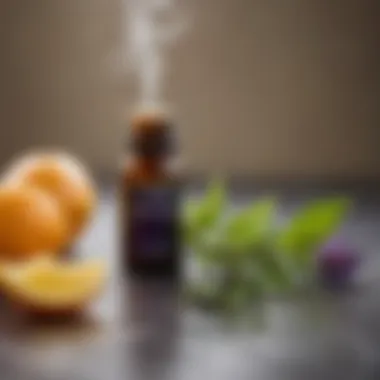What Makes Clothes Smell Good: A Comprehensive Exploration


Intro
The pleasant scent of clothes is often taken for granted. Yet, it plays a significant role in how we perceive cleanliness and freshness. Many factors influence this aspect, ranging from the types of fabrics to the detergents we choose. Understanding these elements can lead to an improved clothing care routine. This article provides an in-depth look at what makes clothes smell good and offers practical tips for maintaining that freshness.
Factors Influencing Clothing Fragrance
A variety of influences contribute to the aroma of garments. These can be categorized into several segments, including the fabric, washing agent, and environmental conditions. Each component offers distinct contributions to the final scent experienced by the wearer or anyone nearby.
Fabrics
The material itself can have a notable impact on how scents adhere to clothing. Natural fibers such as cotton and linen tend to absorb and retain fragrances better than synthetic ones like polyester. Consequently, individuals seeking a particular scent might prefer garments made from natural materials.
Detergents and Softeners
Detergents are crucial in cleaning clothes, but their formulation can also enhance or detract from their scent. Many commercial detergents contain added fragrances that can be long-lasting and potent. Fabric softeners also play a role, often making clothes feel softer while embedding additional scents. Exploring various brands and formulations can lead to finding the right product that aligns with personal preferences.
Environmental Effects
The environment in which clothes are stored can significantly influence their smell. Factors like humidity, temperature, and exposure to other scents can alter how clothing retains or loses its fragrance. Proper storage is vital. Keeping clothing in a dry, cool area will help maintain that fresh scent longer.
"Understanding the main factors influencing clothing fragrance can enhance your overall approach to garment care."
Scent-Enhancing Practices
In addition to washing and storage methods, there are other practices to incorporate. For example, using scented sachets in closets or drawers can infuse garments with pleasant aromas. Similarly, certain laundry boosters designed to enhance fragrance can be beneficial. These products work alongside detergents to prolong freshness.
Practical Tips for a Fresh Scent
Maintaining the fragrance of your clothes involves a comprehensive understanding of factors discussed. Here are some practical tips:
- Choose the Right Fabric: Opt for natural fibers for better scent retention.
- Select Quality Detergents: Research options that provide long-lasting fragrance.
- Store Wisely: Keep clothes in a ventilated space to reduce mustiness.
- Refresh Regularly: Consider using fabric sprays designed for freshening clothing.
By implementing these practices, individuals can enjoy the pleasant experience of fresh-smelling clothing consistently. Understanding the nuances of fabric, detergent choice, and environmental conditions will empower anyone in pursuit of ideal clothing care.
Understanding Fabric and Scent
Understanding fabric and scent plays an essential role in comprehending why clothes can smell nice or otherwise. The type of fabric influences how scents attach to textiles. Different fibers have distinct properties that can either retain or release fragrances.
Natural fibers, like cotton, wool, and silk, tend to hold scents better due to their porous structure. This allows for the absorption of fragrances and, in some cases, captures odors as well. Conversely, synthetic fibers, such as polyester and nylon, usually repel moisture and, thus, may not hold scents in the same way. This distinction makes it vital to choose the right fabric if a pleasant fragrance is desired.
The benefits of understanding fabrics extend beyond scent. Choosing the right materials can impact comfort, durability, and maintenance. A well-informed choice can lead to more satisfaction and longevity in clothing. Keeping these considerations in mind is crucial for maintaining a desirable scent in garments.
Natural vs. Synthetic Fibers
The debate between natural and synthetic fibers often centers on their properties and benefits. Natural fibers are generally more breathable and have a more comfortable feel against the skin. Cotton, for instance, absorbs moisture well, allowing for scents to be captured effectively. This is one reason why cotton garments often smell fresher after washing. Furthermore, natural fibers can also have an intrinsic scent, often mild and pleasant.
In contrast, synthetic fibers tend to be more durable and resistant to wrinkling and shrinking. However, their ability to hold on to fragrance can be limited. For instance, polyester has a tighter weave that often prevents odors from being absorbed. Instead, scents may wash away more quickly with synthetic fabrics.
Ultimately, selecting between natural and synthetic fibers depends on personal preference and purpose. Some prefer natural fabrics for their scent retention capabilities, while others might prioritize durability and ease of care.
Impact of Textile Weaves
Textile weaves also impact how fabrics can hold or release scents. Different weaving techniques can create varied texture and density, influencing the interaction with air and moisture. For example, looser weaves may lead to greater airflow, enabling the retention of scents without holding on to unwanted odors.
Tighter weaves, while potentially more resistant to moisture, can trap odors. In such cases, it may require more intensive washing methods to fully eliminate smells. The weave type also plays a role in the way fragrances are infused into fabrics. Some weaves may enhance the fragrance experience, making it more appealing, while others may hinder it.
The Chemistry of Detergents and Fabric Softeners
Understanding the chemistry behind detergents and fabric softeners is vital for maintaining and enhancing the fragrance of clothing. These products are not merely helpers in cleaning; they are intricately designed to tackle various challenges that fabrics encounter. Knowing how they work will assist anyone in making informed choices about laundry processes.
Fragrance Mechanisms in Detergents
Detergents utilize a range of chemical compounds to achieve their cleaning powers, which also play a crucial role in scent. The primary components include surfactants that lower the surface tension of water, allowing it to penetrate fabric fibers more effectively. This is essential for removing dirt, stains, and odors that tend to cling.
In addition to surfactants, most detergents contain fragrance compounds. These compounds are crafted to provide not just cleanliness, but also a pleasant scent upon washing. These fragrances can operate in various ways:
- Microencapsulation: Some formulas incorporate microcapsules containing fragrance oils. These capsule release their contents gradually over time, allowing scents to linger on fabrics.
- Odor Neutralizers: Chemical agents specifically designed to neutralize odors can also contribute to the overall fragrance. They interact with odor-causing substances, effectively masking undesirable smells.


However, it is important to consider sensitivity to certain fragrances. Many brands offer unscented options for those who prefer to avoid synthetic scents. Choosing the right detergent that combines effective cleaning power with a pleasing fragrance is key to achieving good results.
Fabric Softeners: Enhancing Aroma
Fabric softeners are frequently added to laundry routines to enhance not only the tactile qualities of fabrics but also their scent. These products work through a simple chemical process. The primary agents are usually cationic surfactants, which bind to the negatively charged fibers in clothing. This reduces friction, making fabrics feel softer and appear less wrinkled.
Beyond the tactile benefits, fabric softeners introduce additional scent through fragrance additives. These scents can be more potent compared to detergents since softeners are often used in smaller quantities, allowing for a more concentrated application. Effectively:
- Prolonged Scent Release: Similar to detergents, many fabric softeners contain encapsulated fragrances that are released during wear. This mechanism ensures that clothes smell fresh long after they are washed.
- Compatibility with Detergent Scent: When using both detergent and fabric softener, it's crucial to consider the fragrances that complement each other. A disparate scent profile can lead to a less pleasant overall aroma.
Ultimately, integrating the right combination of detergent and fabric softener can greatly enhance the aroma of clothing. It is recommended to perform personal tests to assess compatibility with one’s own sensitivities. For more information, various resources like Wikipedia, Britannica offer deeper insights into specific products and their formulations.
"The right detergent and fabric softener can transform your laundry experience, ensuring freshness and comfort in every wear."
In summary, a significant comprehension of the chemistry behind these products will allow individuals to make better choices regarding their laundry. Having a grasp of fragrance mechanisms not only enhances how clothing smells but also aids in creating a more pleasant environment during wear.
Environmental Factors Affecting Scent
Understanding how environmental factors influence the scent of clothing is crucial. Humidity and moisture retention play a significant role in how clothes smell. Similarly, the air quality where clothing is stored directly impacts odor absorption. This section will delve into these elements to paint a comprehensive picture of their effects on scent.
Humidity and Moisture Retention
Humidity affects scent retention in various ways. High humidity levels can make fabrics absorb moisture, which can lead to musty odors. When clothes are damp, bacteria and mold thrive, causing unpleasant smells. It is essential for individuals to recognize the importance of a dry environment for storing clothing.
- Use of Dehumidifiers: Investing in dehumidifiers can significantly reduce moisture in storage areas, which helps in maintaining freshness.
- Drying Techniques: After washing, ensure your clothes are thoroughly dried. Line drying outdoors also allows fabric to receive natural air, helping to keep it fresh.
High humidity also affects how fragrance interacts with the fabric. In conditions of elevated moisture, the scent can become overwhelming or distorted, potentially ruining the intended aroma of essential oils or fabric softeners used. Minimizing moisture not only keeps clothes smelling good but also helps preserve the integrity of the fabric.
Air Quality and Odor Absorption
Air quality is another significant factor affecting how clothing retains scent. Poor air quality can lead to undesirable odors being absorbed by fabrics. For example, smoke, pollution, and stale indoor air can infiltrate clothing fibers, resulting in lingering smells.
"Air quality impacts not just human health; it also affects the olfactory characteristics of textiles."
To mitigate this issue, consider the following strategies:
- Ventilation: Ensuring proper airflow in storing areas reduces the chances of unwanted smells. Opening windows or using air purifiers can enhance air quality.
- Avoiding Contaminants: Keep clothing away from sources of strong odors, such as cooking areas and areas with heavy smoke or pollution.
It’s essential to recognize that while effective washing and fragrance-enhancing products contribute positively, if clothes are subjected to poor air quality, their scent can be compromised. By being mindful of environmental factors, individuals can take steps to ensure that their clothing not only smells good but also remains healthy and well-preserved.
Methods of Scent Enhancement
Enhancing the scent of clothes goes beyond using detergent alone. It involves a thoughtful approach to incorporating fragrance at multiple stages of garment care. Methods of scent enhancement can significantly elevate not just the experience of wearing clothing but also the perception of cleanliness and freshness.
Selecting the right enhancement method is crucial for achieving a pleasant aroma. Essential oils, scented dryer sheets, and sachets are among the popular solutions. These methods provide versatility in personalizing scents, enabling individuals to express their preferences while maintaining a clean odor profile in their fabrics.
Using Essential Oils
Essential oils offer a natural way to infuse garments with fragrance. These concentrated plant extracts provide a variety of scents, from fresh citrus to calm lavender. They can be added directly to washing machines or diluted in a spray bottle for application after washing.
- Natural Scent: Essential oils are derived from plants, ensuring a fresh and non-chemical smell.
- Customization: Users can mix different oils to create a unique scent tailored to their preferences. For example, combining lemon and eucalyptus creates an invigorating aroma.
- Antimicrobial Properties: Some essential oils have antibacterial or antifungal traits, which can help in keeping clothes fresher for longer.
- Application: It is advisable to test a small area first, as some oils may affect the fabric's color or structure. A few drops can also be added to dryer balls for an even scent distribution.
"Using essential oils in clothing care not only enhances the fragrance but also adds a personal touch that reflects the user’s identity."
Scented Dryer Sheets and Sachets
Scented dryer sheets and sachets are common tools for achieving fresh-smelling garments. These products are designed to release fragrance during the laundry cycle. Drying clothes with scented sheets can impart a lasting aroma that is often associated with fabric softeners.
- Convenience: Dryer sheets are easy to use. Just toss one into the dryer for added fragrance.
- Variety: Different brands offer unique scents, allowing for choices aligned with personal preferences. Popular choices include fresh linen, lavender, and tropical scents.
- Sachets: Fabric sachets filled with aromatic materials, like lavender or cedar, can be placed in closets or drawers to keep clothes smelling pleasant. They can be refreshed with essential oils when the scent fades.
- Longevity: Scented products provide prolonged aroma retention compared to washing alone, making them suitable for long-term storage of garments.
Incorporating these methods provides a comprehensive approach to maintaining a pleasing scent in clothing. It empowers individuals to select products and techniques that best suit their lifestyle and preferences.
The Role of Washing Techniques
Washing techniques play a crucial role in ensuring that clothes smell fresh and pleasant. Proper washing not only removes dirt and stains but also affects how scents interact with fabrics. When considering the importance of washing methods, it's essential to focus on several specific elements. These include the selection of detergents, water temperature, and washing cycle duration. Each component has a significant impact on preserving or enhancing the fragrance of clothing.
Washing is the first step in a process that can determine the longevity of scents in your wardrobe. Effective washing techniques also contribute to the overall cleanliness of garments, which influences how they smell over time. Additionally, understanding the benefits and considerations associated with washing can help achieve better results for a fresher scent that lasts.


Optimal Washing Practices
To achieve the best results in washing clothes, a few optimal practices stand out. One key practice involves sorting clothes by fabric type and color. Washing delicate fabrics separately helps avoid damage, maintaining the fabric's texture and scent.
- Choose the Right Detergent: Select a detergent that aligns with your scent preferences. Detergents with added fragrance can enhance the overall smell of clean clothes.
- Adjust Water Temperature: For most fabrics, washing in cold or warm water is advisable. Hot water can strip natural oils and fragrances from textiles.
- Follow Load Size Recommendations: Overloading the washing machine can prevent proper cleaning and rinsing, leading to residual odors.
- Use Proper Wash Cycles: Utilizing gentle cycles for delicates and heavier cycles for robust fabrics ensures clothes are cleaned effectively while preserving scent.
Drying Methods and Their Effects
Once clothes are washed, drying methods come into play. The way garments are dried can significantly impact their scent. Several methods are common, each with distinct effects.
- Air Drying: This method allows for gentle drying, preserving the natural scents of fabrics. Setting clothes outside can add a fresh outdoor scent. However, it's essential to consider the environment, as humidity can lead to mustiness.
- Tumble Drying: Using a dryer on medium heat can help retain scent but may also cause fabrics to lose some fragrance if used excessively. Adding a scented dryer sheet can boost aroma during this process.
- Humidity Management: Ensuring good air circulation in the drying area can minimize odor retention. High humidity can cause clothes to acquire a damp smell, negating previous efforts to clean and scent them effectively.
"Effective washing is not only about cleaning your clothes; it's about enhancing and preserving their scent too."
Storing Clothes for Lasting Fragrance
The way we store our clothes has a significant impact on their lasting fragrance. Proper storage techniques ensure that garments retain their pleasant scents, which can diminish if not managed correctly. Clothes that are consistently exposed to unsuitable conditions may absorb unwanted odors and develop musty smells. Thus, understanding the fundamental principles of effective storing is paramount in maintaining a fresh aroma.
Best Practices for Clothing Storage
Storing clothes with care involves several considerations that directly relate to their scent longevity. Firstly, it is essential to ensure that garments are clean and completely dry before they are stored. Any residual moisture can lead to mold and mildew growth, which will affect both the scent and integrity of the fabric.
Secondly, carefully choosing the storage environment is crucial. Here are several practices to follow:
- Use breathable materials: Opt for cotton or muslin bags over plastic. Plastic can trap moisture and odors, whereas breathable fabric allows for airflow.
- Avoid overcrowding: Storing too many garments in tight spaces can compress fabrics, leading to creases and may also inhibit airflow, allowing scents to become stale.
- Maintain optimal temperatures: Keep clothing in a cool, dry place away from sunlight. Excessive heat can alter fabrics and cause existing scents to fade.
- Regularly check and air out: Periodically take clothes out of storage to let them breathe. This action helps refresh their scent and removes any potential buildup of moisture or odor.
Utilizing Scent-Proof Bins
Scent-proof bins provide an innovative solution for those wanting to maintain the aromas of their clothes. These specialized containers are designed to block out external odors and protect garments from dust and pests. Here are some points about these storage solutions:
- Odor resistance: Scent-proof bins help in preventing unwanted external odors from permeating into your clothes. They create a sealed environment where odors cannot reach.
- Protection from pests: Besides blocking odors, these containers keep clothes safe from insects or critters that can damage fabrics.
- Easy organization: Many scent-proof bins come with organizational features, such as compartments or labeled sections, which enhance accessibility while ensuring that clothes remain organized.
In summary, storing clothes effectively is a key component of preserving their appealing scent. By implementing best practices for clothing storage and utilizing scent-proof bins, individuals can significantly enhance the longevity of their garments' fragrances. This mindful approach adds significant value to wardrobe maintenance and personal aesthetics.
Cultural Perspectives on Scent in Clothing
Scent has always held a prominent place in various cultures. The way clothes smell can be tied to traditions, regional preferences, and individual experiences. Understanding these cultural perspectives offers valuable insights into how scent and clothing intertwine and influence personal identity. Clothing is more than just a protective layer; it often reflects social and cultural values, making scent a key component of this expression.
Regional Fragrance Preferences
Different regions have distinct preferences when it comes to fragrance. For example, in Mediterranean cultures, the use of citrus and floral scents can be a staple, often reflecting the natural environment and a love of freshness. These scents blend perfectly with the warm climate, adding a liveliness to daily attire. In contrast, Scandinavian countries might lean towards warmer, woody scents that evoke feelings of coziness within long winters. This regional variation highlights how the climate and lifestyle inform scent choices in clothing.
Factors influencing these preferences include:
- Climate: Warm regions may favor lighter scents, while colder areas may prefer richer fragrances.
- Local flora and fauna: Many cultures incorporate natural elements from their surroundings into their scent choices.
- Cultural practices: Certain scents may be used for specific events or ceremonies, further deepening their cultural significance.
Traditional Practices and Their Influence
Traditional practices often shape how communities perceive and apply scent in clothing. In some cultures, rituals surrounding scent can infuse garments with personal meaning. For instance, in many South Asian countries, it is common to apply oils before wearing traditional attire. These scents not only hold fragrance but also symbolize the wearer's identity and familial heritage.
Additionally, the use of scent can also be ceremonial. In Japan, for example, the practice of kōdō involves appreciating the aroma of incense, influencing how textiles are scented during cultural events.
Common traditional practices include:
- Infusion of natural scents: This may involve herbs or flowers that are woven into the fabric or used in the storage of garments.
- Seasonal celebrations: Special occasions may see the use of particular scents unique to that time of year, enhancing the cultural significance of the event.
- Herbal remedies: In many cultures, certain scents are believed to provide health benefits, and thus are included in clothing care routines.
Understanding these cultural dimensions enhances one's appreciation of clothing and perfume. It emphasizes how deep-rooted beliefs and practices shape our choices and how scent continues to be a vital aspect of identity.
Allergic Reactions and Sensitivities to Fragrances
The relationship between fragrances and clothing is multifaceted. While pleasant scents can enhance the enjoyment of wearing clothes, they can also trigger adverse reactions in some individuals. Understanding allergies and sensitivities to fragrances is crucial, as it influences product choices and methods of care.
Identifying Common Allergens
Fragrances can contain a variety of compounds. Some people may develop sensitivities to these substances, resulting in discomfort or health issues. Common allergens include:
- Ethanol: Often used as a solvent in fragrance formulations.
- Limonene: A citrus-scented compound that can cause skin irritation.
- Linalool: Present in many floral fragrances, linked to allergic reactions.
- Synthetic Musks: These are often used for their strong scent but can lead to skin issues for some.


It is important to be aware of the ingredients in laundry products and scented fabrics. Always check labels for these potential allergens, especially if you have known sensitivities.
Choosing Hypoallergenic Products
Selecting hypoallergenic products is a practical approach for those sensitive to fragrances. These products generally contain fewer irritants and allergens. Key benefits include:
- Reduced Skin Irritation: Hypoallergenic detergents minimize the chance of dermatitis and other allergic reactions.
- Neutral Fragrances: Many options use unscented formulas or natural aromas that are less likely to provoke sensitivities.
- Dermatologist Tested: Products endorsed by dermatologists provide an extra layer of assurance for safety.
Consider brands like Seventh Generation or Free & Clear when making your choices. These brands focus on creating formulas that prioritize skin health while still maintaining cleanliness.
"Choosing the right fabric care products can make a significant difference for individuals with fragrance sensitivities."
In summary, understanding allergic reactions and sensitivities to fragrances allows consumers to make informed choices. This, in turn, maintains the balance between enjoying pleasant scents and ensuring personal comfort.
Industry Trends in Fragrance Development
The field of fragrance in the textile industry is undergoing significant evolution. Recognizing the importance of scent is vital as it greatly influences consumer preference and product appeal. Current trends emphasize innovation and sustainability, reshaping how fragrances are developed and perceived in clothing care. Businesses are motivated to adopt new practices that enhance the consumer experience through scent while being mindful of environmental impacts.
Technological Advances in Scent Technology
Recent advancements in technology are changing fragrance development. These technologies focus on improving scent delivery and longevity in textiles. For example, encapsulation techniques allow fragrances to be embedded within fibers. This ensures that pleasant odors are released gradually over time, maintaining freshness and appealing scent for longer periods.
Moreover, smart textiles are emerging. They contain sensors that can interact with the environment or the wearer, adjusting the fragrance based on conditions such as temperature or humidity. This breakthrough enhances the personalized scent experience, aligning with modern consumer expectations.
Sustainability and Natural Ingredients
Sustainability is a crucial aspect of current fragrance trends. Consumers are increasingly favoring sustainable practices in the products they choose. Many textile companies are now focusing on using natural ingredients instead of synthetic fragrances. This shift not only reduces the environmental impact but also caters to those with sensitivities to chemical compounds in textiles.
Companies are exploring plant-based fragrances derived from essential oils or extracts. Using these natural scents often provides a more nuanced odor profile, appealing to discerning consumers who prefer organic solutions.
In summary, understanding the industry trends in fragrance development enables consumers to make informed choices while allowing manufacturers to meet evolving market demands. Keeping pace with innovations enhances the overall quality of scented textiles, promoting a satisfying experience for users.
Personalizing Your Scent Experience
Personalizing the scent of your wardrobe is a valid exploration for many reasons. Clothing is not just a visual representation of one’s style; it also conveys nuances of individual identity. The aroma of clothing contributes to this narrative. Tailoring your scent experience allows you to express yourself more distinctly. Specific fragrances can evoke memories or feelings, which further enrich your personal style. In addition, a customized scent can enhance your mood and boost your confidence, influencing how you feel about yourself and how others perceive you.
When thinking about personalizing scents, considerations include the types of fragrances that best align with your personality and lifestyle. Some individuals may prefer floral fragrances while others might go for deeper, woodsy scents. It is vital to identify what resonates most with you.
Creating Signature Scents for Your Wardrobe
Creating a signature scent for your wardrobe involves selecting fragrances that reflect your personal taste. This can be done through a few careful steps. First, identify your favorite fragrance families – do you prefer fresh, fruity scents or something more earthy? Once you know what appeals to you, you can begin to experiment.
Consider using fragrance oils that can be applied to clothing. These can be used sparingly on specific items to avoid overwhelming aromas. Alternatively, you can infuse your laundry routine with signature scents. Using detergents with specific fragrances or incorporating your choice of fabric softeners can create a lasting effect.
Your signature scent can change. Just like your wardrobe choices, your personal scent might evolve over time. Aim to refresh your scent scheme periodically to keep it aligned with your current self.
Investing time in crafting a distinct scent for your clothing is a pathway to self-discovery and personal expression.
Incorporating Seasonal Fragrances
Incorporating seasonal fragrances allows your closet to reflect the changing times. Different seasons evoke various feelings, and aligning your clothing scents accordingly can enhance your overall experience. For instance, fresh citrus or floral scents often work well in spring and summer, while warm, spicy fragrances suit fall and winter.
You can achieve this seasonal switch through multiple methods. Consider using scented sachets containing seasonal herbs or essential oils in your drawers. This method provides a subtle scent that shifts with the seasons without overwhelming your clothes. Additionally, adjusting your fabric softeners and detergents according to seasons can further reinforce the transition in aroma.
Here is a brief list of seasonal fragrance ideas:
- Spring: Lavender, Peony, or Fresh Citrus
- Summer: Coconut, Jasmine, or Watermelon
- Fall: Pumpkin Spice, Cinnamon, or Sandalwood
- Winter: Pined Pine, Wintergreen, or Vanilla
By switching up your scents with the seasons, you can create an olfactory journey that corresponds with your environment and enhances your clothing experience.
The End: The Art and Science of Scented Clothing
The topic of scented clothing is not merely an aesthetic choice. It intertwines with various aspects of daily life, encompassing personal preferences, hygiene, and even emotional well-being. In this article, we have explored a diverse array of elements that contribute to the pleasant smell of clothes.
At its core, understanding the factors that influence scent can significantly enhance your clothing experience. The choice of fabrics plays a crucial role. Natural fibers tend to offer enhanced breathability and a propensity to hold scents better than some synthetic alternatives. This fundamental difference can dictate not only how well your clothes smell after washing but also how they interact with external odors in various environments.
Detergents and fabric softeners are another key consideration. The chemistry behind these cleaning products can either hinder or promote favorable aromas. Familiarity with fragrance mechanisms within these substances can enable you to make informed choices that align with your scent preferences and skin sensitivities.
Moreover, environmental factors, such as humidity and air quality, have been shown to impact how fresh clothes remain over time. Recognizing these influences can aid in adopting proper washing and storing techniques to maintain that desirable freshness.
In addition to all these factors, methods of scent enhancement, such as essential oils and scented dryer sheets, offer practical ways to infuse fragrances into your wardrobe. Such practices can personalize your scent experience, allowing for the creation of a distinctive olfactory signature that reflects your individuality.
"The art of scented clothing merges practical knowledge with personal expression."
As we summarize, the science behind the pleasant scent is interlinked with cultural practices and advancements in fragrance technology. The rise of hypoallergenic and sustainable products is indicative of the growing awareness of human sensitivities and environmental concerns when it comes to scents.















